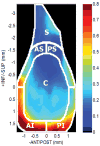Glenoid cartilage mechanical properties decrease after rotator cuff tears in a rat model
- PMID: 22407524
- PMCID: PMC3374903
- DOI: 10.1002/jor.22100
Glenoid cartilage mechanical properties decrease after rotator cuff tears in a rat model
Abstract
Rotator cuff repairs are commonly performed to reduce pain and restore function. Tears are also treated successfully without surgical intervention; however, the effect that a torn tendon has on the glenohumeral cartilage remains unknown. Clinically, a correlation between massive rotator cuff tears and glenohumeral arthritis has often been observed. This may be due to a disruption in the balance of forces at the shoulder, resulting in migration of the humeral head and subsequently, abnormal loading of the glenoid. Our lab previously demonstrated changes in ambulation and intact tendon mechanical properties following supraspinatus and infraspinatus rotator cuff tendon tears in a rat model. Therefore, the purpose of this study was to investigate the effects of supraspinatus and infraspinatus rotator cuff tears on the glenoid cartilage. Nine rats underwent unilateral detachment of the supraspinatus and infraspinatus tendons and were sacrificed after 4 weeks. Cartilage thickness significantly decreased in the antero-inferior region of injured shoulders. In addition, equilibrium elastic modulus significantly decreased in the center, antero-superior, antero-inferior, and superior regions. These results suggest that altered loading after rotator cuff injury may lead to damage to the joint with significant pain and dysfunction. Clinically, understanding the mechanical processes involved with joint damage will allow physicians to better advise patients.
Copyright © 2012 Orthopaedic Research Society.
Figures





References
-
- Neer CS, 2nd, Craig EV, Fukuda H. Cuff-tear arthropathy. J Bone Joint Surg Am. 1983;65:1232–1244. - PubMed
-
- Petersson CJ. Degeneration of the gleno-humeral joint. An anatomical study. Acta Orthop Scand. 1983;54:277–283. - PubMed
-
- Hsu HC, Luo ZP, Stone JJ, et al. Correlation between rotator cuff tear and glenohumeral degeneration. Acta Orthop Scand. 2003;74:89–94. - PubMed
-
- Burkhart SS. Arthroscopic treatment of massive rotator cuff tears. Clin Orthop Relat Res. 2001:107–118. - PubMed
-
- Soslowsky LJ, Carpenter JE, DeBano CM, et al. Development and use of an animal model for investigations on rotator cuff disease. J Shoulder Elbow Surg. 1996;5:383–392. - PubMed
Publication types
MeSH terms
Grants and funding
LinkOut - more resources
Full Text Sources
Medical
Miscellaneous

